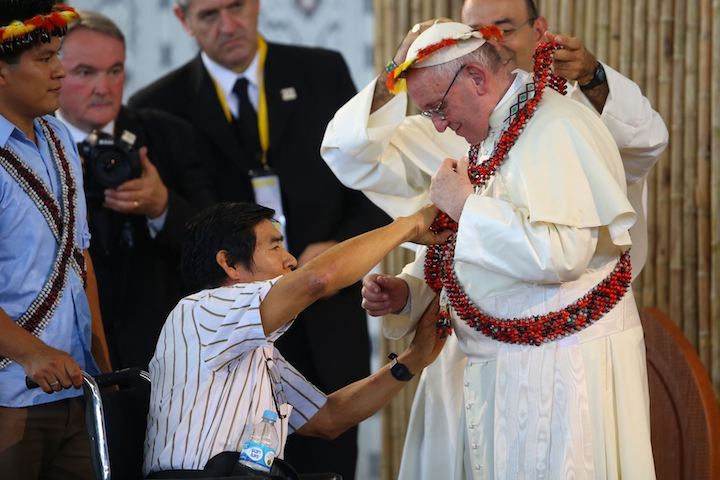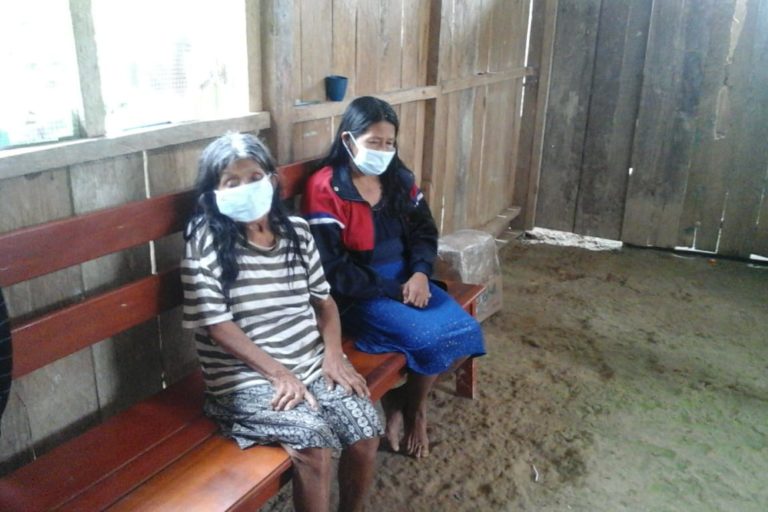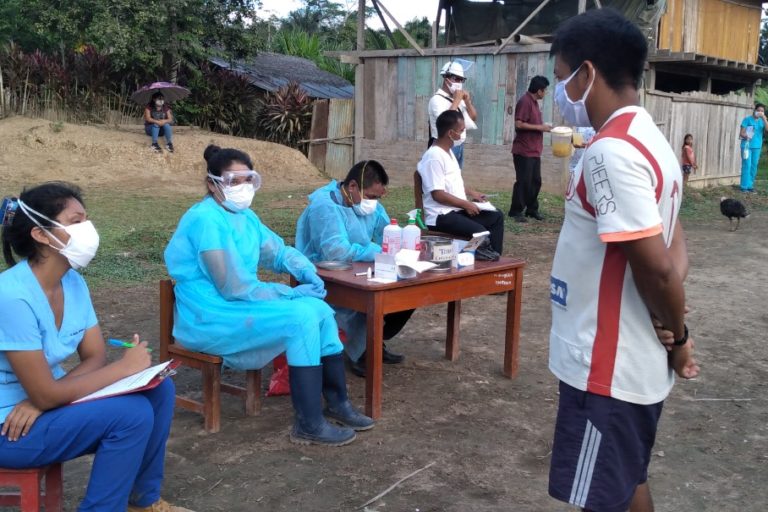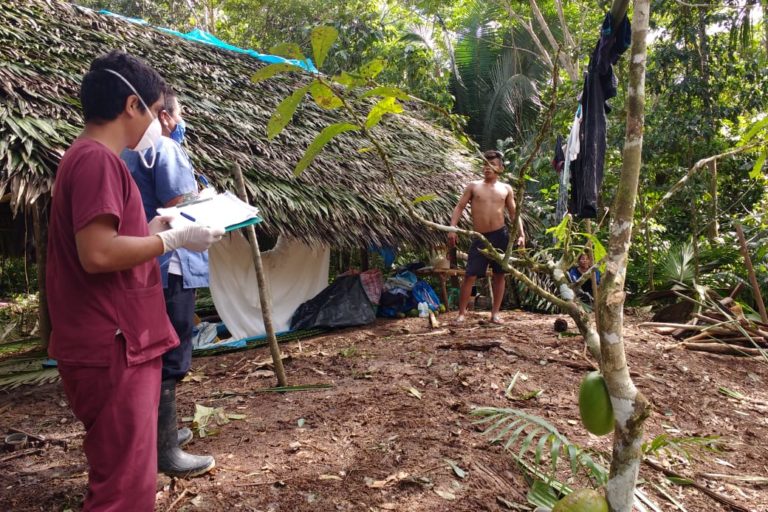- The Ombudsperson’s Office reports that 19 health centers in the Amazonian provinces of Condorcanqui and Bagua, with almost 100,000 inhabitants, have closed as the pandemic takes hold.
- Many of the dead in the Indigenous communities are tribal elders, considered the “spiritual guides” of the communities’ struggle for rights and justice.
- Indigenous leaders accuse the government of neglect in its handling of the pandemic response, especially with regard to Peru’s Amazonian communities.
“This pandemic is taking away our wise men,” Zebelio Kayap, the Indigenous leader of the Organization of Border Communities of Cenepa (ODEFROC), says in a broken voice. Kayap speaks with indignation about what is happening in the communities of the Awajún and Wampis peoples in the Peruvian Amazon.
“So far 35 people have died from coronavirus in the Awajún and Wampis communities. One of them is Santiago Manuin,” Kayap says.
Santiago Manuin Valera fought for his life for two weeks. The Awajún Indigenous leader had survived a submachine gun blast during the Indigenous uprising in Bagua province in 2009 — known as the Baguazo — but died on July 1 of COVID-19.

Manuin died in the city of Chiclayo, a day after being admitted to Luis Heysen Inchustegui Hospital, and after spending several days at Heroes del Cenepa Hospital in Bagua that was not equipped with oxygen. A request for help for Manuin had circulated on social media since June 18, when he was admitted to the health center of Santa María de Nieva, the capital of Condorcanqui province in the Amazon region.
Peru is among the top 10 countries with the highest number of coronavirus infections. According to the umbrella organization of the Indigenous organizations of the Amazon Basin (COICA) there are currently 3,639 Indigenous people confirmed to have COVID-19 in Peru, and a death toll of 379. That makes it the second-highest Amazonian country, after Brazil, for the number of cases of Indigenous people affected by the pandemic.
The wisdom that is being lost
“The leaders who have gone before us are the spiritual guides of our struggles and we will always hold them in our minds,” says Wrays Pérez, president of the autonomous territorial government of the Wampis nation, who adds there are several other Indigenous Awajún leaders who have died due to the COVID-19 pandemic.
Manuin in particular was recognized worldwide for his fight in defense of his people’s territory. In 2014 he was recognized with the National Human Rights

The same day that Manuin died, on July 1, Francisco Juwao Untsumak, who served multiple terms as mayor of Santa María de Nieva, also died in Condorcanqui province.
Among other Awajún leaders who have also died from COVID-19 are Hernán Kinin Inchipish, a communicator with the Regional Organization of Indigenous Peoples of the Northern Amazon of Peru (ORPIAN-P) and of the Inter-Ethnic Association for the Development of Selva Peruana (AIDESEP); and his brother, Arturo Kinin Inchipish. Both, along with Manuin, were charged in the 2009 Indigenous protest in Bagua against oil exploration activities in the Peruvian Amazon. The Kinin Inchipish brothers were still on trial at the time of their deaths.

Pérez, the Wampis leader, says other Indigenous leaders have also lost their lives in the past month, including Jabian Antun Marcial Trigoso, Solicio Impi, Gerardo Shimpukat Vicente Esash, Alejandro Paati, Carmen Wasmit, Melida Yanua, and Hilda Nachijan — all considered wise men of the Awajún people.
“It is the indifference and neglect of the government. A historical debt that the state owes us. We are about to celebrate 200 years of independence, but the government does nothing for the peoples of the Amazon border,” Pérez says of the Wampis people.
“This does not weaken us; on the contrary, it strengthens us,” says Pérez, who hails from the Galilea community in Río Santiago, one of the three border districts of Condorcanqui.

Pérez says they have sent a letter to the government asking it to listen as a matter of urgency to the Indigenous communities of the region in the face of the spread of the coronavirus. If they are not heeded, he says, he doesn’t rule out filing a lawsuit against the government.
In the Amazon region, the number of people testing positive for the virus doubled in the last two weeks of June. According to official figures from the Regional Health Directorate (DIRESA) of the Amazon, as of June 15, 1,214 people had tested positive for COVID-19 and 33 had died as a result of the disease. By July 5, DIRESA had reported 3,192 positive cases and 99 deaths.
Cash grant clusters
During the first months of the pandemic, the Indigenous communities in the Amazon region remained isolated, with their borders closed and strict monitoring in place. However, the return of Indigenous people who lived in other cities in Peru and the displacement of the population for grants provided by the state undermined the preventive measures that the Awajún and Wampis communities had adopted.

Evelio Paz Tume, a doctor and head of the Huampami micronetwork of health centers in the Cenepa border district, says that in April there were no cases of COVID-19 in the Indigenous communities of the region. “The communities closed their borders and did not let anyone through.” After the government issued a decree on April 14 authorizing the movement of people living away from their habitual residence or workplace, the situation began to change, Paz says.
“The return of the migrants was supposed to be subject to certain biosecurity criteria, but some were not complied with and there were some people who even escaped from the places where they were meant to quarantine,” Paz says.
The situation worsened with the distribution of the emergency grants by the government. “That is how the community transmission began. Days after the grants were received, there were patients with symptoms,” he says, adding he’s now recovering from COVID-19 himself.

Paz says he and his health center staff traveled to the four communities where the grants would be distributed: Huampami, Mamayaque, Wawain and Pampa Entsav. “We visited stores to recommend that they implement every possible biosafety measure, requested that masks be distributed, and that hand-wash kits be installed in ports, squares and stores.”
But crowding couldn’t be avoided. “People from across the district, from about 70 communities, gathered in those four places to collect the grants and benefits from the Juntos program,” Paz says. Traders also came to sell their products. Days after these gatherings, Paz and his team began receiving calls from people reporting symptoms of a “very bad flu.”
According to the 2018 district and provincial poverty map, Condorcanqui province is among the 10 poorest in Peru. “There is a high rate of child malnutrition, HIV, diabetes and high blood pressure,” Paz says.
Shapiom Noningo Sesen, technical secretary of the autonomous territorial government of the Wampis nation, says the Awajún and Wampis peoples had complied with the quarantine since the government announced a state of emergency throughout Peru. “We closed the borders and entry to the communities. It worked for two months, but then the Indigenous brothers and sisters who were in the cities returned and were left without any work or money. That’s how the infections started.”

Noningo also points to the grant payments as one of the causes of the spread of the contagion. “In my area, in Río Santiago district, the grants were distributed in June and the brothers and sisters had to move to populated centers where the pandemic was already present. They traveled to the community of Belén, where there were cases of COVID-19. Now the symptoms are already appearing in other communities,” he says.
Noningo says a similar situation played out in Morona and Cenepa districts. The coronavirus has now spread through the Morona, Pastaza, Cenepa, Corrientes and Santiago river basins. “Despite the authorization of a fund for Indigenous communities, until now there have not been any medicines or biosecurity equipment in the communities and health personnel have resigned for fear of contagion,” Noningo says.

He says he’s complained to the local and regional governments, but that his requests haven’t been met by Governor Óscar Altamirano. Mongabay Latam called the governor for comment on the situation of the Awajún and Wampis communities in the Amazon, but received no response. The governor’s office agreed to return the call but hadn’t done so by the time this article was published.
The Ministry of Development and Social Inclusion (MIDIS) says the payment of the grants to the beneficiary households was made through securities transport companies (STC) in vehicles considered a safe payment mechanism because of sanitary security measures established by the Ministry of Health (MINSA), including the deployment of non-infected personnel.
In a written response to Mongabay Latam, MIDIS says there “is no evidence or epidemiological analysis that proves a link between the payment mechanism for the different financial subsidies and any possibility of contagion of the population,” and that “There were already official cases detected throughout the Amazon corridor where the payment operations have taken place, before they began.”

The ministry says the payments were made in ongoing coordination with mayors and community chiefs, as well as with the regional directorates of health and culture, and that the allocation of the payment locations was determined according to the place of residence recorded on the beneficiaries’ ID cards.
MIDIS also denies the possibility that the distribution of the subsidies from the Juntos program was a source of contagion.
Shortages in the border communities
Paz says that since the beginning of the health emergency, health centers in the Amazon have been asking the Condorcanqui provincial health authorities and DIRESA to send them medicines, biosecurity equipment, rapid test kits, and oxygen to care for those affected by COVID-19.

He says that in the health center he runs only four people remain of the 22 who worked there before the pandemic. This center is in charge of the network of health posts in Cenepa district. “There are 20 centers that must serve a population that exceeds 15,000 people in 72 communities and we do not have a single doctor,” Paz says.
Chávez Wajuyat Shimbucat, a member of the Indigenous Mobile Emergency Care System (SAMU), has traveled through eight communities in the border area between Peru and Ecuador. During this journey, he has treated more than 300 people who presented with symptoms of COVID-19. “The health posts do not have medicines. Some have even closed due to lack of personnel. We have obtained donations of medicines to deliver to the communities, but it is not enough. Indigenous brothers and sisters are using traditional plants.”
Wajuyat also keeps a tally of the dead in the Indigenous territories. He says that in Cenepa, seven people have died, and in Santa María de Nieva, two. He also says that after the distribution of the emergency grants, the contagion spread throughout the region.

As of July 3 there were 529 cases of COVID-19 in Condorcanqui province, with the highest concentration in the town of Nieva, according to information sent by the Ministry of Health to Mongabay Latam. In the district of Imaza in Bagua province, more than 406 cases of COVID-19 were reported during the same period.
“There are no medicines or medical personnel in the health posts. The governmenthas not taken the Amazon region into account,” Indigenous leader Zebelio Kayap says about the health situation facing the region.
He says there’s been a lack of preparation by authorities in the face of the pandemic, with health posts not set up. “We warned that if the virus reached our communities it would be devastating, but the government paid no attention to our claims,” Kayap says.

On July 5, the Ombudsperson’s Office reported that 19 health facilities — 13 in Condorcanqui and six in Bagua — had closed, citing a shortage of health workers after several were infected with COVID-19.
The situation in Peru’s Amazon region only came to light after the Ombudsperson’s Office remotely supervised the 133 health centers in the two provinces, which cover 387 Indigenous localities and 94,313 people from the Awajún and Wampis communities.

“A solution must be found soon,” says Nelly Aedo, head of the Indigenous peoples program at the Ombudsperson’s Office. “People in these communities cannot access treatment and there are almost 100,000 people in the Awajún and Wampis villages. The Amazon region requires urgent attention.”
The Ministry of Health says it maintains ongoing contact with the health networks and micronetworks in the Amazonian region. Its Directorate of Indigenous or Native Peoples has rapid tests, molecular tests, medicines for the treatment of COVID-19 and other pathologies, as well as oxygen concentrators, ventilators, masks for community use, and protective equipment for health personnel in the area, the ministry says.
In its written response to Mongabay Latam, it says that close to 690,000 units of protective equipment have been distributed to health personnel in the Amazon region so far, with oxygen tanks provided to health care facilities there. It also says 40 oxygen concentrators have been delivered and that another 40 are on their way, in addition to the 1,200 oxygen concentrators that will be acquired for exclusively use by health facilities that serve Indigenous populations.
Banner image: Santiago Manuin. Image courtesy CAAAP.
This story was first reported by Mongabay’s Latam team and published here on our Latam site on July 6, 2020.
